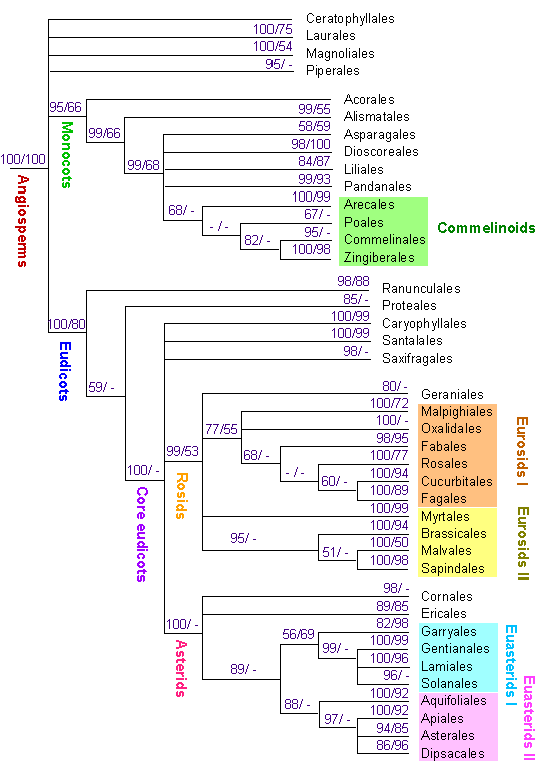Original URL: http://www.systbot.uu.se/classification/APG.html
The Angiosperm Phylogeny Group (1)
AN ORDINAL CLASSIFICATION FOR THE FAMILIES OF FLOWERING PLANTS
Recent cladistic analyses are revealing the phylogeny of flowering plants in increasing detail, and there is support for the monophyly of many major groups above the family level. With many elements of the major branching sequence of phylogeny established, a revised suprafamilial classification of flowering plants becomes both feasible and desirable. Here we present a classification of 462 flowering plant families in 40 putatively monophyletic orders and a small number of monophyletic, informal higher groups. The latter are the monocots, commelinoids, eudicots, core eudicots, rosids including eurosids I and II, and asterids including euasterids I and II. Under these informal groups there are also listed a number of families without assignment to order. At the end of the system is an additional list of families of uncertain position for which no firm data exist regarding placement anywhere within the system.
(1)This paper was compiled by Kåre Bremer, Mark W. Chase, and Peter F. Stevens, equally responsible and listed here in alphabetical order only, with contributions from Arne A. Anderberg, Anders Backlund, Birgitta Bremer, Barbara G. Briggs, Peter K. Endress, Michael F. Fay, Peter Goldblatt, Mats H. G. Gustafsson, Sara B. Hoot, Walter S. Judd, Mari Källersjö, Elizabeth A. Kellogg, Kathleen A. Kron, Donald H. Les, Cynthia M. Morton, Daniel L. Nickrent, Richard G. Olmstead, Robert A. Price, Christopher J. Quinn, James E. Rodman, Paula J. Rudall, Vincent Savolainen, Douglas E. Soltis, Pamela S. Soltis, Kenneth J. Sytsma, and Mats Thulin (in alphabetical order). Addresses: K. Bremer, Department of Systematic Botany, Uppsala University, Villavägen 6, S-752 36 Uppsala, Sweden; M. W. Chase, Jodrell Laboratory, Royal Botanic Gardens, Kew, Richmond, Surrey, TW9 3DS, U.K.; P. F. Stevens, Harvard University Herbaria, 22 Divinity Avenue, Cambridge, Massachusetts 02138, U.S.A.
PUBLISHED 1998 IN
ANNALS OF THE MISSOURI BOTANICAL GARDEN 85: 531-553.
Go
to APG classification
Go to APG
synonyms
Classification 1998

Phylogenetic interrelationships of the orders of flowering plants, compiled from recent cladistic analyses cited in the text. Jackknife support ist given on the branches (in dash for values < 50%), first jackknife values from analysis of 545 sequences of rbcL, atpB, and 18S rDNA genes (D. E. Soltis, M. W. Chase, P. S. Soltis, D. Albach, M. E. Mort, V. Savolainen, M. Zanis & J. S. Farris, unpublished, in prep.) and second jackknife values from analysis of 2538 rbcL sequences (Källersjö, M., J. S. Farris, M. W. Chase, B. Bremer, M. F. Fay, C.J. Humphries, G. Petersen, O. Seberg & K. Bremer 1998. Simultaneous parsimony jackknife analysis of 2538 rbcL DNA sequences reveals support for major clades of green plants, land plants, seed plants and flowering plants. Pl. Syst. Evol.213, 259-287)
The electronic version of the the phylogenetic tree was prepared by R. Bergmann & P. v. Sengbusch, The diagram was converted in an interactive map. The links connect to the family lists of the APG Classification.